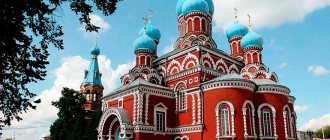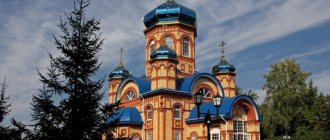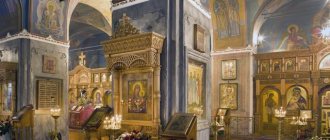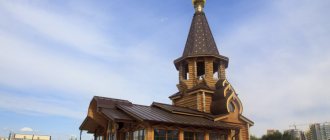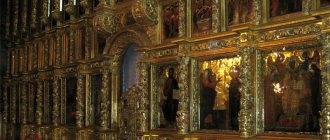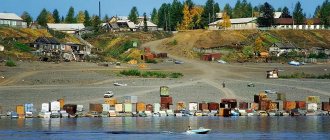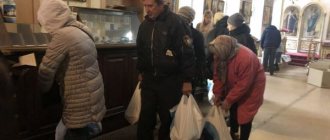| Bishkek and Kyrgyzstan diocese Russian Orthodox Church Central Asian Metropolitan District | |
Resurrection Cathedral in Bishkek | |
| basic information | |
| A country | Kyrgyzstan |
| Diocesan center | Bishkek |
| Founded | July 27, 2011 |
| Number of deaneries | 6 |
| Number of temples | 46 |
| Cathedral Church | Resurrection Cathedral (Bishkek) |
| Sanctification of the ruling bishop | Bishop |
| Title of the ruling bishop | Bishkek and Kyrgyzstan |
| Website | www.eparchia.kg/ |
| Bishop | |
| Ruling bishop | Daniil (Kuznetsov) |
| With | July 25, 2014 |
Bishkek and Kyrgyzstan diocese
(Kyrgyzstan Bishkek zhana Kyrgyzstan diocese) is a diocese of the Russian Orthodox Church within the state borders of the Kyrgyz Republic. It is part of the Central Asian Metropolitan District.
Cathedral city - Bishkek. Cathedral - Resurrection (Bishkek).
Story
Christianity began to penetrate into the territory of Kyrgyzstan from the first centuries of the new era. According to Metropolitan Vladimir (Ikim) of Central Asia and Bishkek, Apostle Thomas or Twin Thomas was the first to bring the news of the Savior to Central Asia: “The road of Apostle Thomas ran through the Kyrgyz land,” the Metropolitan writes in his book, “through Osh and Uzgent”[ 1].
Orthodoxy on the territory of Kyrgyzstan began to actively develop with the beginning of the mass resettlement of Russian peasants and Cossacks. The first were the Siberian Cossacks who settled in the northern part of Semirechye. The civilian population—merchants and peasants—settled near the Cossack fortifications, in which military marching churches were set up as an integral part of the life of society[2].
On May 4, 1871, the Turkestan diocese was formed by separating from the Orenburg diocese with its center in the city of Verny[3]. The new diocese also included the territory of Kyrgyzstan[2].
The first Orthodox parishes appeared in Kyrygizia in the 1870s. Initially they were military, but with the appearance of the migrant population in Turkestan, Orthodox parishes lost their military status, and then permanent churches were rebuilt. The first church on the territory of the republic was built in the village of Teploklyuchenka[2].
From 1926 to 1929 there was a Pishpek vicariate of the Tashkent diocese.
Formed by separation from the Tashkent and Central Asian diocese by the definition of the Holy Synod of July 27, 2011 with inclusion in the newly formed Central Asian Metropolitan District[4][5].
On July 18, 2012, the Diocesan Historical Museum was opened in Bishkek, becoming the first and only museum of Orthodox culture in Kyrgyzstan. The museum exhibits collections of icons, awards of the Russian Empire, photographs of pre-revolutionary and modern churches, and an archive of materials about the first Russian settlers[6].
In June 2014, an attempt was made to force Bishop Theodosius (Gazhu) to leave the country[7].
Bishkek Cathedral - a temple in honor of the Resurrection of Christ
Bishkek Cathedral of the Resurrection of Christ is the central church in Bishkek. Her address: Bishkek, Zhibek-Zholu Avenue, 495/6. The temple was consecrated in honor of the great feast of the Resurrection of our Lord Jesus Christ.
The Church of the Resurrection of Christ in Bishkek belongs to the Bishkek and Kyrgyz diocese. In 1947, it was consecrated by the Bishop of Tashkent and Central Asia - Guriy Egorov
But after the establishment of secular power in Bishkek, all churches began to close over time. For example, St. Nicholas Church was turned into an art museum after closing, and St. Seraphim Church was turned into an orphanage.
The question of creating an Orthodox church in Kyrgyzstan was raised in 1943. In December 1944, the territory for the construction of the future temple was offered; the Bishop of Tashkent and Central Asia, Kirill Pospelov, blessed its construction.
While the construction of the temple was underway, services were held right in the open air. The reconstruction of the temple was carried out according to the design of the architect V.V. Veryuzhsky.
In addition to the temple, a tent-roofed bell tower was erected. There were 2 thrones built in the temple. One is in honor of the Resurrection of the Lord, the second is in honor of St. Alexis. In 1947, it was consecrated by the Bishop of Tashkent and Central Asia - Guriy Egorov.
In 1947, the Church of the Resurrection of Christ in Bishkek was consecrated by the Bishop of Tashkent and Central Asia - Guriy Egorov
The icons were collected from various churches closed under Soviet rule. The best ones belonged to the end of the 19th century - the beginning of the 20th century. In 1995, construction of a diocesan spiritual and administrative center began in the church fence of the Holy Resurrection Cathedral with the blessing of Archbishop Vladimir Ikim of Tashkent and Central Asia.
The building was built quite quickly, in one year. It housed a hall for pastoral meetings, an office, as well as a reception room for the bishop and his chambers.
Deanery districts
| List of deanery districts of the diocese | |||
| Name | Dean | Central Temple | Territory |
| Bishkek | archpriest | Resurrection Cathedral | Bishkek |
| Chui-Tokmokskoe | priest Alexander Atamanov | Church of the Holy Great Martyr George the Victorious | Tokmok |
| Belovodskoe | Priest Alexy Makhrov | Temple of the Holy Spirit | Belovodskoe village |
| Issyk-Kul | Archpriest Sergiy Chuvichkin | Church of the Holy Trinity | Issyk-Kul |
| Oshskoe | Archpriest Victor Reimgen | Temple of the Archangel Michael | Osh region |
| Talas | Archpriest Dimitry Shushpanov | Church of the Holy Great Martyr Demetrius of Thessalonica | Talas |
Among the news of the diocese you can see the work of the VII scientific and theological readings
Most recently, on November 9, 2021, a section on the topic “History of the Church in Central Asia” took place in the conference hall of the spiritual and educational center of the Holy Resurrection Cathedral.
On this day, November 9, the first days of work took place - the VII scientific and theological readings. They were led by the Orthodox historian Ekaterina Evgenievna Ozmitel.
VII scientific and theological readings in Bishkek, headed by Orthodox historian Ekaterina Evgenievna Ozmitel
She emphasized how important these readings are. At this moment there is a unification of the clergy and Orthodox historians. Many guests were invited and presented their reports.
The head of the department of historical disciplines of the Almaty Theological Seminary, Archpriest Andrey, made a report. He spoke about the life of the holy martyr Pimen Belolikov.
All guests of the spiritual and educational center listened to the reports of the speakers. The work of the section ended with a report by the rector of the church, Archpriest Vadim Alekseev, on the height and dignity of the Patriarch of Moscow as represented by Metropolitan Joseph.
Also on this day there was a conference of the Temperance Society. The event was moderated by the head of the Bishkek and Kyrgyz diocese, the cleric of the church, Deacon Andrey Tonkikh.
Conference – “Sobriety Societies”. The event was moderated by the head of the diocese - church cleric Deacon Andrey Tonkikh
On December 28, 2021, the activities of the social department of the diocese held the “Santa Claus Post” campaign in the spiritual and educational center of the Resurrection Cathedral.
By leaving a comment, you accept the user agreement
Temples
As of 2011, the Bishkek and Kirigiz diocese includes 6 dean districts, 25 churches, 20 houses of prayer and 1 nunnery.[8]
- Holy Resurrection Cathedral (Bishkek)
- Church of the Holy Equal-to-the-Apostles Grand Duke Vladimir (Bishkek)
- Church of the Nativity of the Blessed Virgin Mary (Leninskoye village)
- Church of the Intercession of the Mother of God (Kant)
- Temple in honor of the icon of the Mother of God “Joy of All Who Sorrow”, Novo-Pokrovka village
- Church of the Intercession of the Mother of God (Tash-Tyube village)
- Temple of the Kazan Icon of the Mother of God (Vasilievka village)
- Church of the Holy Great Martyr George the Victorious (Chui-Tokmok)
- Church of the Holy Apostle and Evangelist John the Theologian (Ivanovka village)
- Temple of the Kazan Icon of the Mother of God (Orlovka village)
- Temple of St. Seraphim of Sarov (Krasnaya Rechka village)
- Church of the Intercession of the Mother of God (Kemin village)
- Temple of St. Blessed Xenia of Petersburg (Balykchy)
- Church of the Holy Trinity (Karakol)
- Temple of the Hieromartyr Veniamin, Metropolitan of Petrograd (Cholpon-Ata)
- Church of the Intercession of the Mother of God (Kyzyl-Suu)
- Church of St. Nicholas the Wonderworker (Ananyevo village)
- Temple of the Kazan Icon of the Mother of God (Tyup village)
- Church of the Holy Great Martyr Demetrius of Thessalonica (Teploklyuchenka village)
- Temple of the Archangel Michael (Semenovka village)
- Church of the Intercession of the Blessed Virgin Mary (Grigoryevka village)
- Temple of the Archangel Michael (Osh)
- Temple of the Assumption of the Mother of God (Jalal-Abad)
- Temple of the Prophet Elijah (Kyzyl-Kiya)
- Church of the Nativity of the Blessed Virgin Mary (Kok-Yangak)
- Temple of St. Seraphim of Sarov (Kara-Kul)
- Temple of the Vladimir Icon of the Mother of God (Miluu-Suu)
- Temple of the Tikhvin Icon of the Mother of God (Aidarken)
In 1996, the celebration of the 125th anniversary of the Orthodox diocese throughout Central Asia was celebrated
In 1996, the 125th anniversary of the Orthodox diocese was celebrated throughout Central Asia. In this regard, Patriarch of Moscow and All Rus' Alexy II came to congratulate on this wonderful event. By order of the President of Kyrgyzstan Askar Akayev, it was decided to expand the territory of the Resurrection Cathedral.
In connection with the celebration of the 125th anniversary of the Orthodox diocese throughout Central Asia, Patriarch of Moscow and All Rus' Alexy II came to congratulate the residents on this wonderful event
The entire complex of church buildings was surrounded by a new fence and gate. Since 1999, the chapel in honor of St. Alexis began to be decorated with icons and frescoes. Many icons were painted by the Bishkek icon painter Evgenia Postavnicheva.
Since 2000, construction has not stopped on the territory of the temple. The altar part of the cathedral was enlarged, and the construction of a large two-story administrative building was completed, which housed a conference room, a library and much more.
In 2021, the great consecration of the Resurrection Cathedral took place, which was led by His Holiness the Patriarch of Moscow and All Rus' - Kirill Gundyaev.
In 2021, the consecration of the Resurrection Cathedral in Bishkek was carried out by His Holiness Patriarch of Moscow and All Rus' - Kirill
Diocesan departments
- Department of Education and Catechesis in the Name of St. equal to Vl. Book Vladimir
- Information and publishing center in the name of St. equal to Cyril and Methodius
- Church and archaeological department in the name of St. Schema-Archbishop Anthony (Abashidze)
- Department of Social Ministry in the Name of St. right John of Kronstadt
- Youth Department in the name of the Apostle and Evangelist John the Theologian
- Architectural and Construction Department in the name of St. Joasaph of Belgorod
- Prison Ministry Department
- Department for work with the armed forces
- Sisterhood of Charity in the Name of St. prpmch. Elisaveta Feodorovna
- Brotherhood in the name of St. Nicholas the Wonderworker.
Notes
- [www.gumilev-center.su/khristianskaya-svyatynya-na-dne-issyk-kulya/ Christian shrine at the bottom of Issyk-Kul | Lev Gumilyov Center in Kyrgyzstan]
- ↑ 123
I. Yu. Barteneva [scjournal.ru/articles/issn_1993-5552_2010_7_02.pdf Orthodoxy in Kyrgyzstan (second half of the 19th - early 20th centuries)] - [planeta-imen.narod.ru/almaata/X.html History of the Turkestan diocese. General information]
- [www.patriarchia.ru/db/text/1586149.html Journals of the meeting of the Holy Synod of July 27, 2011] (Journal No. 67). Patriarchia.Ru.
- [www.pravmir.ru/obrazovan-sredneaziatskij-mitropolichij-okrug/ The Central Asian Metropolitan District was formed]. Orthodoxy and peace.
- [www.eparchia.kg/otdely/7 Museum – Departments of the Bishkek and Kyrgyz diocese]
- [www.aif.kg/novosti/obschestvo/7594-bez-episkopa-ostalas-bishkekskaya-i-kyrgyzstanskaya-eparhiya.html The Bishkek and Kyrgyz Diocese was left without a bishop]
- [www.eparchy.kg/index.html Official website of the diocese]
Currently, the administrator of the diocese is Bishop Daniel of Bishkek and Kyrgyzstan
Currently, the administrator of the diocese is Bishop Daniel of Bishkek and Kyrgyzstan.
The diocese has its own official website, which contains a lot of information about the life of the diocese, the archpastor and the entire clergy. Also on the site you can read the news that is posted every day and the schedule of services of Bishop Daniel.
Official website of the Bishkek and Kyrgyzstan diocese
In recent news, on November 4, on the day of the celebration of the Kazan Mother of God, the Bishop of Bishkek celebrated the Divine Liturgy in the Church of the Kazan Icon of the Mother of God. The Temple of the Kazan Mother of God is located in the village of Vasilyevka.
On the day of the celebration of the Kazan Mother of God, Bishop Daniel of Bishkek performed the divine liturgy in the Church of the Kazan Icon of the Mother of God in the village of Vasilyevka, Bishkek diocese
After the liturgy, Bishop Daniel of Bishkek and Kyrgyzstan addressed the parishioners with an archpastoral word. On the day of the celebration of the Kazan Icon of the Mother of God, Archpriest Valentin Nikonov, Archimandrite Peter, and rector of the church Leonid Ignatov concelebrated with the bishop.
Links
Monasteries Monastery of the Kazan Icon of the Mother of God (female) Temples Bishkek Deanery Cathedral of the Resurrection (Bishkek) • Church of the Holy Equal-to-the-Apostles Prince Vladimir (Bishkek) • Pokrovsky (Kant) • Church of the Nativity of the Blessed Virgin Mary (Leninskoye village) • Sorrowful Church (Novo-Pokrovka village) • Intercession Church (Tash-Debe village) • Boris and Gleb Church (Voenno-Antonovka village) • Temple of Righteous John of Kronstadt (Manas village)
Chui-Tokmok Deanery Temple of St. George the Victorious (Tokmak) Belovodsk Deanery Temple of the Holy Spirit (Sokuluk village) Issyk-Kulk deanery Church of the Holy Trinity (Karakol) Osh deanery Temple of the Archangel Michael (Osh) Talas deanery Church of the Holy Great Martyr Demetrius of Thessalonica (Talask) * - inactive.
Monasteries Trinity St. George's Monastery (Chirchik) • Trinity St. Nicholas Women's Monastery (Tashkent) • Pokrovsky Women's Monastery (Dustabad) • Kazan Icon of the Mother of God Convent (Kyrgyzstan) Bishops Vikenty (Morar) • Pitirim (Tvorogov) • Daniil (Kuznetsov) • Theophylact (Kuryanov) Other Tashkent Theological Seminary —- other countries Argentine • Baku • Berlin • Brussels • Budapest • Vienna • Vilna • The Hague • Korsun • Sourozh Autonomous churches Chinese PC Beijing • Xinjiang • Tianjin • Harbin • Shanghai Japanese PC Kyoto • Sendai • Tokyo Self-governing churches Ukrainian PC Alexandria • Baltska • Belotserkovskaya • Berdyansk • Boryspilska • Vinnitsa • Vladimir-Volynska • Voznesenskaya • Volynska • Gorlovska • Dzhankoyska • Dnepropetrovsk • Donetsk • Zhytomyr • Zaporozhye • Ivano-Frankivsk • Izyumska • Kamenets-Podilska • Kamenska • Kyiv • Kirovograd • Konotop • Kremenchug • Krivoy Rog • Luhansk • Lviv • Mogilev-Podolsk • Mukachevo • Nizhyn • Nikolaev • Novokakhovsk • Ovruch • Odessa • Poltava • Rivne • Rovenkovsk • Romensk • Sarnensk • Severodonetsk • Simferopol • Sumy • Ternopil • Tulchin • Uman • Feodosia • Kharkov • Kherson • Khmelnitsky • Khust • Cherkasy • Chernihiv • Chernivtsi • Shepetovsk
Human Rights Center of Moldova Beltsy • Edinet • Cahul • Kishinevskaya • Tiraspol • Ungheni
Latvian PC Daugavpilsskaya • Rizhskaya Estonian Human Rights Center Narvskaya • Tallinskaya ROCOR Berlin • British • East American • Geneva • Montreal • San Francisco • Sydney • Chicago • South American Exarchates Belarusian Exarchate Bobruisk • Borisov • Brest • Vitebsk • Gomel • Grodno • Lida • Minsk • Mogilev • Molodechno • Novogrudok • Pinsk • Polotsk • Slutsk • Turov
Metropolitan districts Kazakhstani Astanaiskaya • Karaganda • Kokshetau • Kostanay • Pavlodar • Petropavlovsk • Ural • Ust-Kamenogorsk • Chimkent
Central Asian Bishkek • Dushanbe • Tashkent • Patriarchal parishes in Turkmenistan
Patriarchal parishes of the Moscow Patriarchate Italy • Canada • USA • Finland
Excerpt characterizing the Bishkek and Kyrgyz diocese
Historians, answering this question, describe to us the actions and speeches of several dozen people in one of the buildings in the city of Paris, calling these actions and speeches the word revolution; then they give a detailed biography of Napoleon and some people sympathetic and hostile to him, talk about the influence of some of these people on others and say: this is why this movement occurred, and these are its laws. But the human mind not only refuses to believe in this explanation, but directly says that the method of explanation is not correct, because with this explanation the weakest phenomenon is taken as the cause of the strongest. The sum of human arbitrariness made both the revolution and Napoleon, and only the sum of these arbitrarinesses tolerated them and destroyed them. “But whenever there have been conquests, there have been conquerors; every time there were revolutions in the state, there were great people,” says history. Indeed, whenever conquerors appeared, there were wars, the human mind answers, but this does not prove that conquerors were the causes of wars and that it was possible to find the laws of war in the personal activity of one person. Every time, when I look at my watch, I see that the hand has approached ten, I hear that the gospel begins in the neighboring church, but from the fact that every time the hand comes to ten o’clock when the gospel begins, I I have no right to conclude that the position of the arrow is the reason for the movement of the bells. Every time I see a steam locomotive moving, I hear the sound of a whistle, I see the opening of a valve and the movement of the wheels; but from this I have no right to conclude that the whistle and movement of the wheels are the causes of the movement of the locomotive. The peasants say that a cold wind blows in late spring because the oak bud is unfurling, and indeed, every spring a cold wind blows when the oak tree is unfurling. But although the reason for the cold wind blowing when the oak tree unfurls is unknown to me, I cannot agree with the peasants that the cause of the cold wind is the unfurling of the oak bud, only because the force of the wind is beyond the influence of the bud. I see only the coincidence of those conditions that exist in every life phenomenon, and I see that, no matter how much and in what detail I observe the hand of a clock, the valve and wheels of a locomotive and the bud of an oak tree, I do not recognize the reason for the bell, the movement of the locomotive and the spring wind . To do this, I must completely change my point of observation and study the laws of the movement of steam, bells and wind. History should do the same. And attempts to do this have already been made. To study the laws of history, we must completely change the subject of observation, leave kings, ministers and generals alone, and study the homogeneous, infinitesimal elements that lead the masses. No one can say how much it is possible for a person to achieve an understanding of the laws of history through this way; but it is obvious that on this path only lies the possibility of grasping historical laws and that on this path the human mind has not yet put one millionth of the effort that historians have put into describing the acts of various kings, generals and ministers and in presenting their considerations on the occasion of these acts . The forces of twelve languages of Europe rushed into Russia. The Russian army and population retreat, avoiding a collision, to Smolensk and from Smolensk to Borodino. The French army, with ever-increasing speed, rushes towards Moscow, towards the goal of its movement. The strength of its swiftness, approaching the target, increases, just as the speed of a falling body increases as it approaches the ground. A thousand miles away is a hungry, hostile country; There are dozens of miles ahead, separating us from the goal. Every soldier of the Napoleonic army feels this, and the invasion is approaching by itself, by sheer force of swiftness. In the Russian army, as they retreat, the spirit of bitterness against the enemy flares up more and more: retreating back, it concentrates and grows. There is a clash near Borodino. Neither one nor the other army disintegrates, but the Russian army immediately after the collision retreats just as necessarily as a ball necessarily rolls back when it collides with another ball rushing towards it with greater speed; and just as inevitably (although having lost all its strength in the collision) the rapidly scattering ball of invasion rolls over some more space. The Russians retreat one hundred and twenty versts - beyond Moscow, the French reach Moscow and stop there. For five weeks after this there is not a single battle. The French don't move. Like a mortally wounded animal, which, bleeding, licks its wounds, they remain in Moscow for five weeks, doing nothing, and suddenly, without any new reason, they run back: they rush to the Kaluga road (and after the victory, since again the battlefield remained behind them near Maloyaroslavets), without engaging in a single serious battle, they ran even faster back to Smolensk, beyond Smolensk, beyond Vilna, beyond the Berezina and beyond. On the evening of August 26, both Kutuzov and the entire Russian army were confident that the Battle of Borodino had been won. Kutuzov wrote to the sovereign in this way. Kutuzov ordered preparations for a new battle in order to finish off the enemy, not because he wanted to deceive anyone, but because he knew that the enemy was defeated, just as each of the participants in the battle knew it. But that same evening and the next day, news began to arrive, one after another, about unheard-of losses, about the loss of half the army, and a new battle turned out to be physically impossible. It was impossible to give battle when information had not yet been collected, the wounded had not been removed, shells had not been replenished, the dead had not been counted, new commanders had not been appointed to replace the dead, people had not eaten or slept. And at the same time, immediately after the battle, the next morning, the French army (due to that rapid force of movement, now increased as if in the inverse ratio of the squares of the distances) was already advancing by itself on the Russian army. Kutuzov wanted to attack the next day, and the whole army wanted this. But in order to attack, the desire to do so is not enough; there needs to be an opportunity to do this, but this opportunity was not there. It was impossible not to retreat to one transition, then in the same way it was impossible not to retreat to another and a third transition, and finally on September 1, when the army approached Moscow, despite all the strength of the rising feeling in the ranks of the troops, the force of things demanded so that these troops march for Moscow. And the troops retreated one more, to the last crossing and gave Moscow to the enemy. For those people who are accustomed to thinking that plans for wars and battles are drawn up by commanders in the same way as each of us, sitting in his office over a map, makes considerations about how and how he would manage such and such a battle, questions arise as to why Kutuzov didn’t do this and that when retreating, why he didn’t take up a position before Fili, why he didn’t immediately retreat to the Kaluga road, left Moscow, etc. People who are used to thinking like this forget or don’t know those inevitable conditions in which the activities of every commander in chief always take place. The activity of a commander does not have the slightest resemblance to the activity that we imagine, sitting freely in an office, analyzing some campaign on the map with a known number of troops, on both sides, and in a certain area, and starting our considerations with what some famous moment. The commander-in-chief is never in those conditions of the beginning of some event in which we always consider the event. The commander-in-chief is always in the middle of a moving series of events, and so that never, at any moment, is he able to think through the full significance of the event taking place. An event is imperceptibly, moment by moment, cut into its meaning, and at every moment of this sequential, continuous cutting of the event, the commander-in-chief is in the center of a complex game, intrigue, worries, dependence, power, projects, advice, threats, deceptions, is constantly in the need to respond to the countless number of questions proposed to him, always contradicting one another. Military scientists tell us very seriously that Kutuzov, much earlier than Filey, should have moved troops to the Kaluga road, that someone even proposed such a project. But the commander-in-chief, especially in difficult times, faces not one project, but always dozens at the same time. And each of these projects, based on strategy and tactics, contradicts one another. The commander-in-chief's job, it would seem, is only to choose one of these projects. But he cannot do this either. Events and time do not wait. He is offered, let’s say, on the 28th to go to the Kaluga road, but at this time Miloradovich’s adjutant jumps up and asks whether to start business with the French now or retreat. He needs to give orders now, this very minute. And the order to retreat takes us off the turn onto the Kaluga road. And following the adjutant, the quartermaster asks where to take the provisions, and the head of the hospitals asks where to take the wounded; and a courier from St. Petersburg brings a letter from the sovereign, which does not allow the possibility of leaving Moscow, and the rival of the commander-in-chief, the one who undermines him (there are always such, and not one, but several), proposes a new project, diametrically opposed to the plan for access to the Kaluga road; and the forces of the commander-in-chief himself require sleep and reinforcement; and the venerable general, bypassed by a reward, comes to complain, and the inhabitants beg for protection; the officer sent to inspect the area arrives and reports the exact opposite of what the officer sent before him said; and the spy, the prisoner and the general doing reconnaissance - all describe the position of the enemy army differently. People who are accustomed to not understanding or forgetting these necessary conditions for the activity of any commander-in-chief present to us, for example, the situation of the troops in Fili and at the same time assume that the commander-in-chief could, on September 1, completely freely resolve the issue of abandoning or defending Moscow, whereas in the situation of the Russian army five miles from Moscow this question could not have arisen. When was this issue resolved? And near Drissa, and near Smolensk, and most noticeably on the 24th near Shevardin, and on the 26th near Borodin, and on every day, hour, and minute of the retreat from Borodino to Fili.
